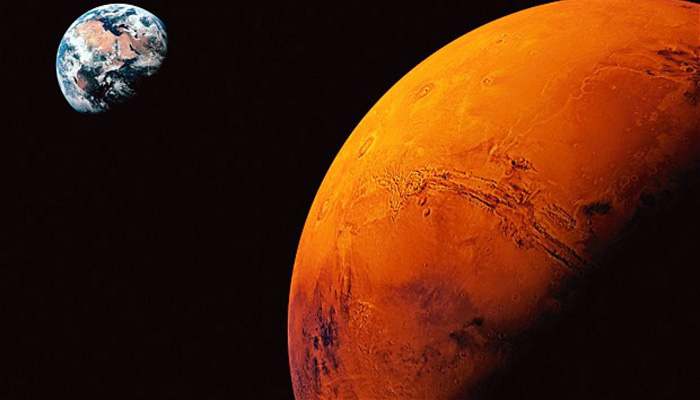It’s been about 12,000 years since Earth’s glaciers last retreated, having finished carving out the Great Lakes, depositing boulders in strange places, and generally giving the northern hemisphere a makeover. But that does not mean Earth’s most recent ice age is over. We are currently in an interglacial, a warmer period sits between the longer glacial periods of an ice age, which itself lasts a few million years.
Mars has ice ages, too, but its temperature swings are more extreme. According to scientists, the Red Planet is emerging from an ice age of its own, following several rounds of climate change. Radar evidence says this retreat began about 370,000 years ago.
Understanding this history gives scientists a window into Mars’ deeper past, helping them understand when the planet’s climate might have been friendly to life. But the story of Mars is also a fable for Earth. Understanding the Martian climate, and what causes its ice ages, can help us learn more about why they happen here—at a time when the intricacies of Earth’s climate are of great concern.
Isaac Smith has been looking at Texas-sized curlicues in the Martian ice caps for eight years, trying to connect them to the planet’s climate history. Smith, a postdoctoral researcher at the Southwest Research Institute in Boulder, Colo., used the Mars Reconnaissance Orbiter’s shallow radar instrument to peek beneath the ice cap on Mars’ north pole. He studied two-dimensional radar slices, which enabled him to see the ice in cross-section, like looking at a road cut or a layer cake. He found something that surprised him: The polar ice cap is active. Ice is constantly piling up and eroding, not just in one spot but everywhere.
Wind erosion forms the ice cap’s curlicues, and they build up over time. By tracing several layers of the whorls, Smith could see changes in ice accumulation and flow.
“Everywhere we looked, there was this change from erosion to deposition,” Smith says. “And I realized those are moving over time. They move like sand dunes move. That turned on this idea, like, ‘Wait a minute, there’s something that’s happening that’s huge, and it’s covering the whole ice cap simultaneously.’”
The whorls were moving because the winds were shifting, Smith says. And that means, even in Mars’s wispy atmosphere, there are dramatic changes that affect the entire climate.
Mars is a dynamic place
Smith and his colleagues noticed that the ice is accumulating at an increasing rate, so the cap is getting thicker, especially at the uppermost 300 to 1,000 feet. Indeed, the poles have gained about 21,000 cubic miles of ice in the past 370,000 years, most of it in the north.
That may seem counterintuitive, since Mars’ ice age is in retreat. An ice cap packing on more ice would seem to be evidence of things getting colder, not warmer. But on Mars, ice ages happen in part because of the planet’s crazy wobble. (At least in this solar system, rocky planets wobble on their axes as they orbit the sun.)
This wobbling can change the amount of sunlight that falls on the planet, which has dramatic effects on its ice, temperature and climate. Earth has two wobble periods, one lasting about 20,000 years and another lasting about 100,000 years. During these wobbles, which are called Milankovitch cycles, Earth’s tilt toward the sun varies by about 2 degrees. Scientists suspect these cycles are involved in setting the pace of ice ages.
The Martian wobble is dizzyingly worse—it moves by as much as 60 degrees over roughly the same timescales. That's because Mars lacks a big moon that would help steady it (tiny Phobos and Deimos don't do much), and because nearby Jupiter exerts a pull. The intense Martian wobble means the planet sees much greater variation in sunlight than Earth does. This has some implications for life, which would experience harsh environmental changes. But it has even bigger implications for ice.
A 60-degree tilt toward the sun would warm up the Martian poles, vaporizing water ice and sending it floating into the atmosphere. Newly on the move, the water would then condense at lower latitudes, falling as frost or snow. If you set free all the ice now gathering at Mars’ poles, it could blanket the planet in two feet of frost, Smith says.
“When Mars is in an ice age, it’s going to look very different, even to the human eye in the night sky,” he says. “The ice on the poles is going to transfer to the middle latitudes, so you will have a white Mars rather than a red Mars. It’s going to look white.”
Would a pale snowball Mars hold the same fascination as its current ruddy self? Perhaps. Especially if the ancients who were around to see it knew how much like Earth it was.







Comments